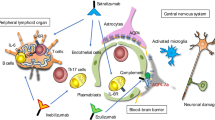Abstract
Neuromyelitis optica (NMO) is an inflammatory disease that selectively affects the optic nerves and spinal cord. The discovery of NMO-IgG targeting aquaporin-4 (AQP4) in NMO patients suggested that NMO is a distinct entity, with a fundamentally different etiology from that of multiple sclerosis (MS). Although NMO usually leads to grave disability because of the more severe tissue destruction compared with classical MS, there have been several reports describing a benign form of NMO over a long disease term. NMO-IgG/AQP4 antibodies show high specificity but medium sensitivity for NMO, while the clinical relevance of AQP4 antibody titers remains to be determined. We aimed to clarify the clinical relevance of AQP4 antibody levels determined by a bridging enzyme-linked immunosorbent assay in 38 patients with NMO or NMO spectrum disorder. The AQP4 antibody levels were higher in patients with optic neuritis (ON) than in those without ON (p = 0.0164). Among the 12 patients examined in a longitudinal study, four showed an increase in the ELISA values during some relapses, and eight showed no clear correlation between the ELISA values and relapse. Of the four patients who demonstrated a steady rise in the antibody levels over time, two patients had no concomitant relapses, despite elevation of the AQP4 antibody levels. We conclude that high AQP4 antibody levels are associated with the occurrence of ON, but that the antibody levels themselves are not closely correlated with the onset of relapse.


Similar content being viewed by others
References
Lennon VA, Wingerchuk DM, Kryzer TJ et al (2004) A serum autoantibody marker of neuromyelitis optica: distinction from multiple sclerosis. Lancet 364:2106–2112
Lennon VA, Kryzer TJ, Pittock SJ et al (2005) IgG marker of optic-spinal multiple sclerosis binds to the aquaporin-4 water channel. J Exp Med 202:473–477
Kira J (2011) Neuromyelitis optica and opticospinal multiple sclerosis: mechanisms and pathogenesis. Pathophysiology 18:69–79
Nakashima I, Fujihara K, Miyazawa I et al (2006) Clinical and MRI features of Japanese patients with multiple sclerosis positive for NMO-IgG. J Neurol Neurosurg Psychiatry 77:1073–1075
Matsuoka T, Matsushita T, Kawano Y et al (2007) Heterogeneity of aquaporin-4 autoimmunity and spinal cord lesions in multiple sclerosis in Japanese. Brain 130:1206–1223
Matsushita T, Isobe N, Matsuoka T et al (2009) Aquaporin-4 autoimmune syndrome and anti-aquaporin-4 antibody-negative opticospinal multiple sclerosis in Japanese. Mult Scler 15:834–847
Koller H, Neuen-Jacob E, Saleh A et al (2006) A patient with a benign course of neuromyelitis optica (Devic’s syndrome) over 12 years: MRI follow up and histological findings. J Neurol 253:819–820
Bergamaschi R, Jarius S, Robotti M et al (2009) Two cases of benign neuromyelitis optica in patients with celiac disease. J Neurol 256:2097–2099
Takahashi T, Fujihara K, Nakashima I et al (2007) Anti-aquaporin-4 antibody is involved in the pathogenesis of NMO: a study on antibody titre. Brain 130:1235–1243
Jarius S, Aboul-Enein F, Waters P et al (2008) Antibody to aquaporin-4 in the long-term course of neuromyelitis optica. Brain 131:3072–3080
Hayakawa S, Mori M, Okuta A et al (2008) Neuromyelitis optica and anti-aquaporin-4 antibodies measured by an enzyme-linked immunosorbent assay. J Neuroimmunol 196:181–187
Waters PJ, McKeon A, Leite MI et al (2012) Serologic diagnosis of NMO: a multicenter comparison of aquaporin-4-IgG assays. Neurology 78:665–671
Isobe N, Yonekawa T, Matsushita T et al (2012) Quantitative assays for anti-aquaporin-4 antibody with subclass analysis in neuromyelitis optica. Mult Scler 18:1541–1551
Wingerchuk DM, Lennon VA, Pittock SJ et al (2006) Revised diagnostic criteria for neuromyelitis optica. Neurology 66:1485–1489
Wingerchuk DM, Lennon VA, Lucchinetti CF et al (2007) The spectrum of neuromyelitis optica. Lancet Neurol 6:805–815
Mader S, Lutterotti A, Di Pauli F et al (2010) Patterns of antibody binding to aquaporin-4 isoforms in neuromyelitis optica. PLoS ONE 5:e10455
Watanabe A, Matsushita T, Doi H et al (2009) Multimodality-evoked potential study of anti-aquaporin-4 antibody-positive and -negative multiple sclerosis patients. J Neurol Sci 281:34–40
Jarius S, Ruprecht K, Wildemann B et al (2012) Contrasting disease patterns in seropositive and seronegative neuromyelitis optica: a multicentre study of 175 patients. J Neuroinflammation 9:14
Yang Y, Huang DH, Wu WP et al (2013) The role of aquaporin-4 antibodies in Chinese patients with neuromyelitis optica. J Clin Neurosci 20:94–98
Blakemore WF, Irvine KA (2008) Endogenous or exogenous oligodendrocytes for remyelination. J Neurol Sci 265:43–46
Tanaka M, Matsushita T, Tateishi T et al (2008) Distinct CSF cytokine/chemokine profiles in atopic myelitis and other causes of myelitis. Neurology 71:974–981
Kim W, Lee JE, Li XF et al (2012) Quantitative measurement of anti-aquaporin-4 antibodies by enzyme-linked immunosorbent assay using purified recombinant human aquaporin-4. Mult Scler 18:578–586
Nishiyama S, Ito T, Misu T et al (2009) A case of NMO seropositive for aquaporin-4 antibody more than 10 years before onset. Neurology 72:1960–1961
Pittock SJ, Lennon VA (2008) Aquaporin-4 autoantibodies in a paraneoplastic context. Arch Neurol 65:629–632
Acknowledgments
This work was supported in part by a Health and Labour Sciences Research Grant on Intractable Diseases (H20-Nanchi-Ippan-016) from the Ministry of Health, Labour and Welfare, Japan, and a grant-in-aid (B; no. 22390178) from the Ministry of Education, Culture, Sports, Science and Technology, Japan.
Author information
Authors and Affiliations
Corresponding author
Electronic supplementary material
Below is the link to the electronic supplementary material.
Rights and permissions
About this article
Cite this article
Isobe, N., Yonekawa, T., Matsushita, T. et al. Clinical Relevance of Serum Aquaporin-4 Antibody Levels in Neuromyelitis Optica. Neurochem Res 38, 997–1001 (2013). https://doi.org/10.1007/s11064-013-1009-0
Received:
Revised:
Accepted:
Published:
Issue Date:
DOI: https://doi.org/10.1007/s11064-013-1009-0




